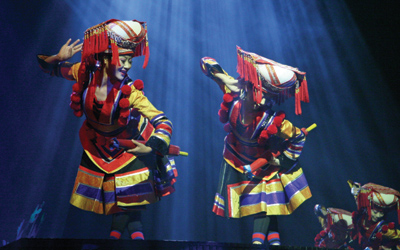Winds of change
Updated: 2012-02-24 16:13
By Chen Jie (China Daily)
|
|||||||||||
 |
|
The show features folk dances from ethnic groups in Guizhou. Provided to China Daily |
Shows like Wind of Colorful Guizhou touring Australia and New Zealand represent a new pattern for cultural exchanges between China and the world. Chen Jie reports.
Thanks to the phenomenal Irish dance show Riverdance, people all over the world know about the music, poetry and history of Ireland.
Now, a dance show highlighting the ethnic culture of Southwest China is touring Australia and New Zealand.
Entitled Wind of Colorful Guizhou, the show features folk songs, dances and customs from more than a dozen ethnic groups - such as the Miao, Buyi and Dong - living in Guizhou province.
Born in Guizhou, the choreographer Ding Wei grew up surrounded by these melodies and dances. He has picked the best of these for the stage.
"Most ethnic groups are good at singing and dancing and to them dancing is a way of life. Many folk dances are derived from their daily lives," the 55-year-old choreographer says.
"The difficult part is to get professional dancers to imitate the movements of real villagers. To begin with, they are not as natural and relaxed as those villagers. But after they spend time living with these villagers, they begin to have an idea of their feelings," he says.
In the number Water Girls, the Miao women display both a feminine shyness, as well as a toughness toward life.
The Dong people have a saying that: "Food feeds the body, while songs feed the soul." Music has a special place in the Dong people's lives. Without a traditional written language, the Dong people have recorded much of their history and culture in their songs.
In the show, you can hear the "big song" (dage in Chinese, galao in the Dong language) of the Dong people, which is a kind of a cappella in different parts, sung by a group of singers in bright voices that have been shaped by the unique environment of the area.
The show also introduces Basha, a small Miao community that continues to live largely like it did 4,000 years ago, with animistic beliefs. It is the country's only area where civilians are permitted to own firearms.
The choreographer creates a dance to showcase the Basha people's worship of trees, equating human life cycles with those of trees. New parents plant a sapling from which their children's coffin will eventually be carved. Hoe blades are placed on the bodies to weigh down the buoyant souls, in case they float away. Another young tree is transplanted atop the burial site, to provide a marker.
It is because of the songs and dance - that go beyond language and culture barriers - that China Arts and Entertainment Group (CAEG) has chosen it for its Image China tour abroad.
CAEG launched Image China in 2009 to send high-quality Chinese shows abroad.
"We want to introduce the best contemporary productions to the West's major theaters, and gradually develop the impact and marketing share of Chinese performing arts abroad," says Zhang Shuxin, vice-president of CAEG, which was founded in 1957 as China's first company engaging in cultural exchange projects.
Zhang says most Chinese shows touring abroad over the past 60 years were financially covered by the government under the label of "cultural exchange". But they seldom sold tickets. Chinese embassies and other Chinese communities would organize audiences for the show, and most of them were Chinese living there.
If not funded by the government, the production is "sold" to a foreign company, which means the foreign agent gives money to the Chinese troupe and then the foreign company does the marketing and everything else required, so the final box office revenue is separated from Chinese company.
Most of the shows feature acrobatics and Peking Opera.
A month ago, Zhang Yu, president of CAEG, won the 2011 CCTV Business Leader of the Year Award. At the ceremony, a young man from New Zealand challenged him: "Do you have anything else except for acrobatics and Peking Opera?"
Zhang had to admit that only acrobatics makes money abroad but, "China does have a variety of performing arts that are not popular or even known to foreign audiences".
Image China has sent abroad Kunqu Opera, dance dramas, Chinese traditional orchestras and Western-style symphony orchestra.
The government financially supports some of the shows. Others partner with local agents and the marketing is done together.
This time, the group has cooperated with AIMG Holdings Pty, and Wind of the Colorful Guizhou played at the Sydney State Theatre on Feb 22 and 23, and will go to Melbourne Regent Theatre on Feb 25 and 26. Then it will move to Bruce Mason Centre, Auckland, on Feb 29 and March 1.
In January 2009, for Image China's first project, the Qingdao Symphony Orchestra performed at the Carnegie Hall and Performing Arts for the Kennedy Center. CAEG collaborated with IMG.
Wang Xiuqin, deputy director of Culture Exchange Division, says CPAA is planning to establish a joint venture with IMG to enter show business in the US.
"Only if we have our own team there, can we know the market and audiences and produce shows to their taste," Wang says.
"We were passive in this field for years. Foreigners chose our shows, marketed our shows and made money. Simply put, acrobatics was easiest for them," Wang says.
"But we can be the boss, too, and we can educate Western audiences to taste a variety of Chinese culture and arts."
This idea represents CAEG's ambitions, but Zhang Shuxin admits CAEG's marketing projects are just 1 percent of its total business.
Though Wind of the Colorful Guizhou tickets cost from 88 to 28 Australian dollars each, the Guizhou provincial government is still contributing 1 million yuan ($158,728) to cover expenses.